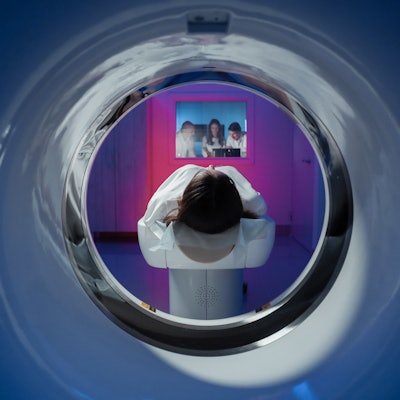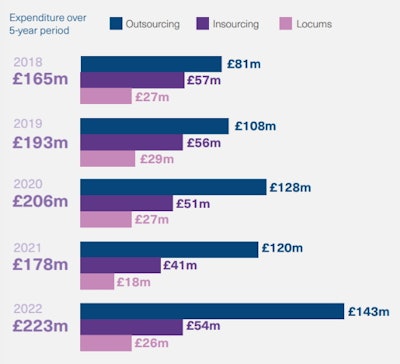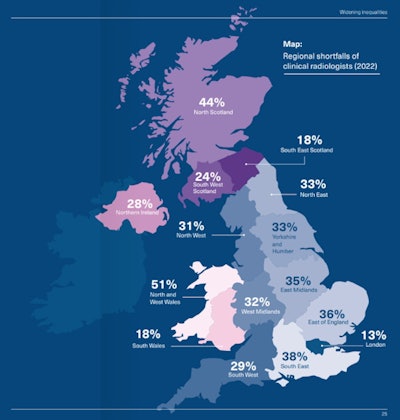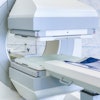
The annual workforce report released on 8 June by the Royal College of Radiologists (RCR) has provided new evidence of the growing reliance of the U.K. on outsourcing as a way of coping with "chronic" staff shortages and the rising demand for imaging.
Spending by the National Health Service (NHS) on outsourcing rose by nearly 20% in 2022, according to the RCR Clinical Radiology Census Report. Insourcing, which involves using radiologists employed within an NHS trust (or hospital group) to report images outside of their core hours, and the use of locum staff are also increasing sharply.
 Outsourcing "is costing us a small fortune," said one clinical director. Source: RCR.
Outsourcing "is costing us a small fortune," said one clinical director. Source: RCR."Whilst the report is couched in polite terms, what the massive growth in outsourcing reveals is a broken NHS radiology service," Dr. Paul McCoubrie, consultant radiologist at Southmead Hospital in Bristol, told AuntMinnieEurope.com. "It isn't threatened. It isn't at risk. NHS radiology is broken. Patients are suffering."
No radiology department wants to outsource, he added. "It is wastefully expensive, and you'd much rather have a known name doing your work. The more you outsource, the more your department is broken."
McCoubrie said he is not aware of a single U.K. radiology department that isn't outsourcing significant chunks of routine work. "The worst thing is that the RCR predicted it two decades ago. For those of us of a certain age, it's been very painful to watch it all unravel."
He noted that more radiologists are leaving the NHS or reducing their NHS sessions to take up more lucrative outsourcing jobs. "NHS pay for consultants has dropped by 35% in real terms over the last 12 years and it's particularly hard for younger consultants with mountains of medical school debt to service. Consultant radiologists are voting with their feet."
Figures from the RCR report support this view: 183 consultants (whole-time equivalents, WTE) left the workforce in 2022, which is well above the five-year average of 151, while around 76% of consultants (WTE) who left the NHS in 2022 were under 60, and the average age of those leaving has dropped from 58 in 2020 to 51 in 2022.
The true cost of outsourcing
Outsourcing may also increase workload due to high levels of re-reporting and reduces training opportunities for trainees, the authors of the RCR report concede. Increasingly, trusts and health boards are being turned away by outsourcing companies, who no longer have spare capacity.
According to one unnamed clinical director, "Outsourcing is costing us a small fortune. We are now finding that our outsourced service is itself maxed out in capacity."
Outsourcing is not a long-term solution for the NHS, but trusts are often unwilling to fund additional trainee posts due to high outsourcing budgets, the report continued.
Another respondent said, "We are sending over 100 scans a day to outsourcing companies, which should be able to fund 5-7 further consultants. I'm told that this outsourcing money cannot be switched to funding posts."
Where are the shortages?
The U.K. as a whole has a 29% shortfall of clinical radiologists, which will rise to 40% in five years without action, and by 2027, an additional 3,365 clinical radiologists will be needed to keep up with demand for services, the report stated.
The workforce grew by 3% in 2022, with the addition of 113 WTE radiology consultants and 15 interventional radiology consultants. Across the U.K., there is a 9% vacancy rate but a 29% shortfall, meaning not enough training posts are being funded to meet demand, the authors wrote. A total of 52% of vacancies have been open for 12 months or more.
 The situation facing the U.K. differs widely across the regions. Source: RCR.
The situation facing the U.K. differs widely across the regions. Source: RCR.This state-of-affairs is unsustainable and is putting patients and healthcare staff under considerable strain, wrote Dr. Raman Uberoi, RCR's medical director for professional practice (clinical radiology), in a foreword to the report.
"The NHS in each UK nation is at a critical turning point," he noted. "Failing to invest in the workforce today will doom to failure any benefits of future innovations."
According to an RCR press statement, the U.K. is sitting on a ticking timebomb in cancer diagnosis and care, putting patients at risk, and more than 75% of clinical oncologists and radiologists who left the NHS in 2022 were under 60.
The RCR's 2022 Clinical Oncology Census, which was also published on 8 June, states that 44% of cancer service managers say they are now "highly concerned" about patient delays; the equivalent figure was 29% a year ago.
"There are examples in almost every cancer centre where parts of the service just aren't running as well as we would like," said Dr. Tom Roques, consultant oncologist and vice-president of the RCR, in a BBC News article. "We're having to tell patients all the time that we can't quite treat them as quickly as we would like, or in the way that we'd like, and that's a stressful thing to have to do."
Workforce: Number 1 issue
On the positive side, McCoubrie said he is glad to see the RCR taking a clear stance on workforce. "It's the most important issue in U.K. radiology at the moment. Everything else pales in comparison."
The RCR report provides "irrefutable evidence" that inadequate numbers of radiologists are being trained, but it has been consistently saying this for 20 years, he explained. The report also confirms that "more radiologists are retiring early, more radiologists are broken by the strain, burnt out and frazzled by the unbearable workload intensity."
The trend towards early retirement is exacerbating the problem and reflects poorly on the NHS as an employer, Dr. Giles Maskell, consultant radiologist at Royal Cornwall Hospitals NHS Trust in Truro and a past president of the RCR, told AuntMinnieEurope.com.
"Urgent attention is required to make the best possible use of our NHS consultants such as adequate administrative and IT support," he said. "This census will add to the pressure on the U.K. government to publish the long-awaited NHS workforce strategy with detailed projections of staff numbers required and the funding to support the required expansion."
Overall, the document "shows what we all expected -- while there have been some welcome and long overdue increases in radiologist training numbers, this expansion is not keeping pace with the increases in demand for imaging," Maskell pointed out.
To download free copies of the clinical radiology and clinical oncology workforce census reports for 2022, go to the RCR website.




















